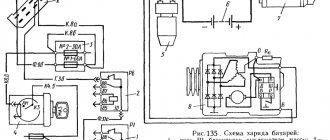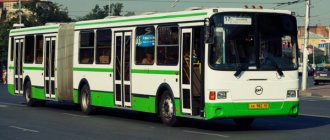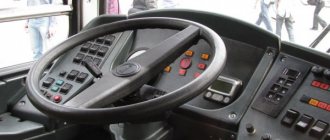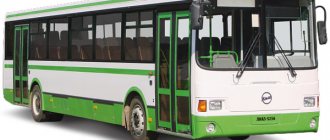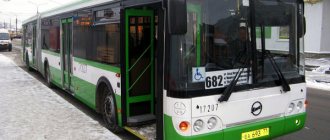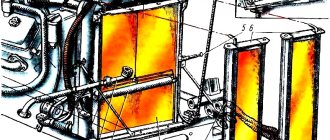BUS LiAZ-529267-11 (EURO-5, engine YaMZ-53624-41). Guide - part 1
Contents INTRODUCTION ……………………………………………………………………………………………………………. 4
GENERAL INFORMATION……………………………………………………………………………….. 7
TECHNICAL CHARACTERISTICS…………………………………………………………………………………………..7
BUS IDENTIFICATION…………………………………………………………………………………………………………………..16
RUN-IN OF THE NEW BUS…………………………………………………………………………………………………………………..17
SAFETY REQUIREMENTS…………………………………………………………………………………………………………..18
General safety requirements…………………………………………………………………………………..18
Safety measures when refueling a bus…………………………………………………………….20
Safety requirements when starting the engine………………………………………………………..21
Safety measures when starting, driving and parking……………………………………………………….21
Safety measures during maintenance and repair………………………………………………………23
Safety measures when towing a bus………………………………………………………25
FILLING THE FUEL SYSTEM WITH GAS …………………………………………………………………………………25
DEGASING OF THE BUS SYSTEM ……………………………………………………………………………………………………………27
BUS MANAGEMENT………………………………………………………………………………………………………………..28
Controls and monitoring devices………………………………………………………..28
Starting the engine……………………………………………………………………………………….49
Stopping the engine……………………………………………………………………………………..52
Start of movement……………………………………………………………………………………………………………53
Selecting the driving mode…………………………………………………………………………………..54
Braking………………………………………………………………………………………………………….55
Bus stop and parking ……………………………………………………………………………………….58
MONITORING THE OPERATION OF BUS SYSTEMS AND UNITS …………………………………………………………………………………..59
Engine operation monitoring……………………………………………………………………………….59
Monitoring the operation of the automatic transmission……………………………………………………………..60
Brake system control……………………………………………………………………………………….61
Monitoring the operation of the power supply system……………………………………………………….62
BODY POSITION CONTROL…………………………………………………………………………………………………………63
LIQUID HEATER CONTROL……………………………………………………………………………………….64
USING THE FIRE FIGHTING SYSTEM………………………………………………………………………………….65
USING THE DRIVER’S PERFORMANCE ACCOUNTING AND CONTROL SYSTEM……………………………………………………67
AUTO INFORMER ORBIT…………………………………………………………………………………………………………..70
EMERGENCY CALL RADIO …………………………………………………………………………………………71
CONTROL OF INTERIOR AIR CONDITIONING…………………………………………………………………………………………………………73
ADJUSTING THE DRIVER'S SEAT………………………………………………………………………………………………………….75
TOWING……………………………………………………………………………………………………………………………………..76
MAINTENANCE…………………………………………………………………………………………………………….78
Types of maintenance………………………………………………………………………………….78
Maintenance frequency…………………………………………………………..79
List of maintenance operations……………………………………………………..79
Daily maintenance………………………………………………………………………………………79
Maintenance T0-1000 ………………………………………………………………………………80
First maintenance (TO-1) …………………………………………………………………………………82
Second technical maintenance (TO-2)………………………………………………………………………………….83
Seasonal maintenance (STO)……………………………………………………………………..85
Additional maintenance operations……………………………………………………..86
Recommendations for the use of lubricants and
technical fluids………………………………………………………………………………….88
Guidelines for selection and use………………………………………………………………………………..88
Chemmotological map…………………………………………………………………………………………..96
DIAGRAM OF GAS FUEL SYSTEM………………………………………………………………………………………………………….100
ELECTRICAL DIAGRAM …………………………………………………………………………………………..100
LiAZ-5292 (with hybrid drive) on CNG methane
LiAZ-5292 with a hybrid drive is a large-class low-floor bus for urban transportation, complementing the range of buses running on alternative fuels (diesel-gas-electricity), and is unified with existing low-floor LiAZ buses in terms of body and types of units. The bus is equipped with a “kneeling” body tilt system, a large storage area equipped with special mounts for wheelchairs, and a ramp for entry/exit, which allows all categories of passengers to feel comfortable.
Operation of the LiAZ-5292 (hybrid) bus in the metropolis will reduce the amount of harmful emissions into the atmosphere and save 25 tons of oxygen annually.
Advantages: – Several times reduction in the level of harmful emissions when driving in the urban cycle; – Reducing fuel consumption by 25-30%; – The use of an internal combustion engine with a power 25-30% lower while maintaining all performance indicators; – Increasing the level of bus comfort (reducing noise, vibration, etc.); – Environmental standard – Euro-5; – Unification with other LiAZ models.
| Basic characteristics | |
| Body type | Load-bearing, all-metal, carriage-type |
| Body life, years | 12 |
| Wheel formula | 4×2 |
| Length/Width/Height, mm | 12000 / 2500 / 3220 |
| Base, mm | 5960 |
| Ceiling height in the cabin, mm | 2295 |
| Floor height above road level, mm | 360 |
| Number/width of doors, mm | 2 / 1325+1 / 1225 |
| Min. turning radius, m | 12,5 |
| Curb/full weight, kg | 11350 / 18000 |
| Load on front/rear axle, kg | 6500 / 11500 |
| Total number of seats (including landing seats) | 87-106(18+2 inv.) |
| Fuel tank capacity, l | 190 |
| Front//rear axle | ZF RL-85 / AV 132/80о |
| Steering gear | ZF Servokom 8098 integral |
| Brake system | Pneumatic, dual-circuit, with axle separation, ABS |
| Ventilation | Natural, through windows and ceiling hatches |
| Heating system | 4 heaters |
| Type of combined power plant | Sequential |
| Aggregate characteristics | |
| Engine (gas) | ZMZ-40529.10 gas with distributed fuel injection |
| Number and arrangement of cylinders | 4R, vertical |
| Type of fuel | Compressed natural gas |
| Environmental safety standards | Euro 5 |
| Working volume, l | 2,46 |
| Location | Transverse in the rear overhang |
| Maximum speed, km/h | 85 |
Source: https://www.bus.ru/index.php/2009-11-05-13-11-00-105/2009-11-05-16-05-56/71-uncategorised/174-5292- 26
If you are interested in this technique, please contact specialists by phone.
see also
PAGZ 6500, mobile gas tanker
New Skoda Scala CNG 2022 on methane
All New Santro on methane from Hyundai India
Methane-powered snow blower based on Freightliner 114SD
Skoda offers parting bonus for gas models
GAZ Group presented new natural gas models at GasSuf 2022
Gas Isuzu CNG ELF at the Comtrans 2017 exhibition
New bi-fuel Volvo V90 methane model
LiAZ 529267
DESCRIPTION
LiAZ-529267 is a large class bus, designed to operate on routes with heavy passenger traffic. New fiberglass masks give the model a modern look. The material does not corrode, is lightweight and low cost. The mask consists of separate components, which increases maintainability and saves money when it is necessary to replace exterior parts. The absence of steps ensures a high speed of passenger exchange, which reduces the route travel time by 15%.
The buses are equipped with a “kneeling” body tilt system, a large storage area equipped with special mounts for wheelchairs, and a ramp for entry/exit, which allows all categories of passengers to feel comfortable.
LIAZ-5292 was recognized as the winner in the “Best Bus of 2014” category of the annual competition “Best Commercial Vehicle of the Year in Russia.”
CHARACTERISTICS BODY LIFE 12 YEARS MAXIMUM SPEED 80KM/H WHEELS FORMULA 4X2 NUMBER OF SEATS 74 -117 SEATS 20..33+1 ECOLOGICAL STANDARD EURO5
RELIABILITY
- High reliability of components and service life of the aggregate base (more than 1 million km)
- Service interval - 30 thousand km
PERFORMANCE INDICATORS
- Increased passenger capacity up to 117 people
- High level of comfort for driver and passengers
- Affordable price
COMFORT*
- Air conditioner
- Audio system
- Tinted double glazed windows
- Electronic route indicators
- Accessibility for all categories of passengers (mechanical ramp)
- Kneeling tilt system
SAFETY*
- DVR for external and internal surveillance
- Digital tachograph
- GLONASS/GPS
- Fog lights
*Is an optional extra and may not be included as standard.
SPECIFICATIONS
PARAMETERS LIAZ-529267 Length/Width/Height, mm 12410 / 2500 / 3139 (2938 for air conditioning) Number/width of doors, mm 3 / 1325 Ceiling height in the cabin, mm 2200…2300
BASIC FEATURES
PARAMETERS LIAZ-529267 Body type Low-floor, load-bearing, all-metal, wagon layout Min. turning radius, m 11.5 Curb/technically permissible weight, kg 9130…11050 / 18000 Load on front/rear axle from technically permissible weight, kg 6500 / 11500 Total number of seats (including landing seats) 75..117 ( 20..33+1 inv.), 74..109 (20..27+1 inv.) Capacity of the fuel tank/gas cylinders, l 297 (220+77) Chassis/axle Front axle: ZF RL-85A dependent, portal with disc brakes, Rear axle: ZF AV-132/870/6.50 portal, with central bevel gear, disc brakes or Hande Axle. Steering gear RB Servocom 8098 with hydraulic power steering Brake system Pneumatic, dual-circuit, with ABS, ASR Ventilation Natural and forced Heating system Liquid, using the heat of the engine cooling system and an independent liquid heater Tires 275 / 70 R 22.5 Base, mm 5960
UNIT CHARACTERISTICS
PARAMETERS YAMZ-53624 Type Diesel engine Number and arrangement of cylinders 6-cylinder, in-line, vertical Environmental safety standards Euro-5 Exhaust and neutralization system 1 muffler with built-in neutralizer and SCR system Engine power, kW (hp)/min 210 at 2300 min-1 Max. torque, Nm/min 1130 at 1100…1600 min-1 Engine location Rear, longitudinal gearbox Automatic transmission: ZF 6AP-1400B (Ecolife) or Voith Diwa D854 Maximum speed, km/h 80
Warranty for the bus is 1.5 years or 150 thousand km.
*All technical specifications are for informational purposes only, please check the exact details by calling the numbers listed in the “Contacts” section.
BUS-CLUB.RU
December 17, 2018 The Likinsky Bus Plant will produce 181 natural gas buses for Moscow.
LIAZ buses will be equipped with modern, economical engines of the EEV (Euro-5+) environmental standard and a multiplex system that monitors more than 300 vehicle operating parameters online. Delivery of the buses is scheduled for the first quarter of 2022. The Likinsky Bus Plant will produce for the capital 118 large-class LiAZ-5292 buses with a passenger capacity of 85 people and 63 articulated buses of a particularly large class LiAZ-6213 with a capacity of 165 passengers.
The buses are equipped with a multiplex system, which every minute scans the operation of all major systems, including those responsible for safety, and transmits information online to the fleet manager.
In accordance with the federal program “Accessible Environment”, all buses are low-floor and equipped with a kniling system (lowering the body down and tilting towards the stop), which makes entry and exit easier for passengers with limited mobility and people with strollers.
LIAZ buses are equipped with an automatic transmission, power steering, GLONASS and ERA-GLONASS systems (the latter, in the event of an accident, will independently signal the emergency services), EBS braking system with ABS and ASR (anti-lock and anti-slip systems that simplify vehicle control on wet or damp roads ). Also, 13 cameras will be installed in each bus, of which 5 are external and 8 are internal, providing a 360-degree view.
The buses are equipped with gas engines of the EEV (Euro 5+) environmental standard, which meets the most stringent European regulations limiting the level of emissions of buses and trucks. The use of EEV engines guarantees high environmental friendliness and cost-effective transportation. Refueling of vehicles with natural gas in Moscow is provided by 10 gas filling facilities, including 5 new automobile gas filling compressor stations. Natural gas is a key alternative to petroleum fuels. Cost of 1 cubic. m at Gazprom gas stations in Moscow is 17 rubles. 50 kopecks By consumption 1 cubic. m of methane is equivalent to 1 liter of gasoline.
Both bus models are designed for urban transportation with heavy passenger traffic.
LiAZ-6212 is the most spacious bus model in Russia (maximum passenger capacity, depending on the modification, can reach 200 people) and the only articulated bus in Russia powered by a gas engine. Topic: Ecology / Natural gas buses
Electricity or methane for the bus?
A replacement for vehicles with a traditional internal combustion engine has been selected for a long time. Actually, among internal combustion engines, the favorites regularly changed: either diesel became the standard, or “suddenly” it turned out that not everything was going well with the environment, and its efficiency was very relative. In any case, the process of searching for the ideal will be endless, since each time makes its own demands.
Today, the main trends in the choice of transport have become its environmental friendliness and efficiency, and for megacities, and this is quite understandable, it is high environmental friendliness that is beginning to become dominant (all other things being equal.) In this regard, electric cars have begun to be considered as the main favorites of the last 10-15 years (or electric hybrids). It would seem that everything is simple and obvious! In fact, the electric motor spins and that’s it, no emissions, pollution or oil stains. Beauty, in a word. However, all this is the tip of the iceberg, but very unpleasant facts are hidden in the underwater layer.
1.The key component of any electric vehicle is the battery.
More precisely, this is from a third to a half of the entire vehicle, but, unfortunately, today the production of such “batteries” is extremely “dirty”. In order for any city to remain clean and use electric transport, entire regions have to be poisoned with waste from the production of batteries, and if we also remember the difficulties with their disposal... In general, the ecology turns out to be very conditional, or rather, very local and only for the “chosen few” , but we will not develop the topic of “dirty” production in detail; we are interested in a completely different part of the problem.
2. Any transport must be efficiently operated.
Ecology is ecology, but no one has canceled the economy and will not cancel it. Unfortunately, in this matter there are no fewer complaints about electric transport (if not more).
What are we talking about? Yes, about money, as usual. We will not go into general discussions, just look at the experience of Moscow (no one doubts that this is a modern and developed metropolis), which announced its intentions to replace traditional diesel public transport with electric ones.
How these decisions were not justified! For example, it was said that the total cost of operating an electric bus is 10% lower than that of a conventional trolleybus, and its service life is 50% longer than that of a diesel bus.
These words were supported by various calculations and an extensive “evidence base” was built around them.
The process of electrification of public transport in Moscow has begun. A little time passed, the “hour X” came and the Ministry of Transport received a report from
Department of Transport of the City of Moscow, which (generally) looked like this:
| Electric bus BK KAMAZ-6482 LiAZ-6274 | Diesel bus NefAZ-5299 LiAZ-529265 | Methane bus LiAZ-529271 | Trolleybus | Tram 71-931M “Vityaz-M” | |
| Passenger capacity | 85 | 85 | 85 | 85 | 185 |
| Costs per passenger seat (RUB per 1 km) | 1,59 | 1,31 | 1,21 | 1,67 | 1,20 |
| Cost of the vehicle (thousand rubles) | 34 089 | 13 173 | 13 136 | 18 000 | 104 348 |
| Cost of battery (thousand rubles) | 9 450 | — | — | — | — |
| Vehicle maintenance and repair (thousand rubles) | 2 016 | 879 | 1 020 | 795 | 3 467 |
| Costs per vehicle unit per year (thousand rubles) | 8 113 | 6 705 | 6 185 | 7 115 | 14 418 |
And what happens with efficiency? And this is what happens:
- FIRST PLACE IS SHARE between an ordinary city tram (71-931M “Vityaz-M”) and a gas-powered bus (LiAZ-529271). For a tram, operating costs are 1.2 rubles per kilometer per passenger seat, for a gas bus - 1.21 rubles. The difference of a penny can be attributed to an error in the calculations.
- “Enemy of the environment” aka diesel bus (NefAZ-5299 and LiAZ-529265) - 1.31 rubles.
- Electric bus - 1.59 rubles.
- Trolleybus - 1.67 rubles.
One more detail:
with a total (planned) service life of an electric bus of 15 years, in 7-8 years its battery will need to be replaced, which costs…. Fanfare!!! So, the bus battery pack costs 9.45 million rubles, while the cost of the electric bus itself is 34 million rubles.
Thus, only the cost of replacing a battery in an electric bus is quite comparable to the price of a regular diesel or gas-powered bus - a little more than 13 million rubles. A trolleybus costs the budget 18 million rubles, and a tram costs 104.3 million rubles. Of course, the tram has a passenger capacity per unit of transport of 185 people versus 85 for buses, but trams are still very expensive for Moscow.
In terms of maintenance and repair costs, the picture is also very interesting:
- 879.6 thousand rubles are spent on regular buses per year;
- for gas buses - 1 million rubles;
- for a trolleybus - 795.7 thousand rubles;
- for an electric bus - 2 million rubles;
- for a tram - 3.47 million rubles.
Now let’s summarize and calculate the annual costs per unit of transport:
- The most effective is a CNG BUS, which costs the capital 6.2 million rubles per year
- Diesel bus - 6.7 million rubles;
- Trolleybus - 7.1 million rubles;
- Electric bus - 8.1 million rubles;
- Tram - 14.4 million rubles per year, but this type of transport can be called endangered. The number of tram lines is small and they are declining
So, it turns out that there is no real alternative to gas public transport, since it turns out to be about 40% more efficient than electric.
But what about the notorious environmental friendliness of the electric bus? Yes, it does have zero emissions, but that's only for the propulsion system itself.
The thing is that the electric bus has a 35 kW Webasto Thermo 350 diesel autonomous heater with a 70-liter diesel tank on board. It is used as a cabin heater and an air curtain over the doors, consumes about four liters of fuel per hour and does not have any additional filters. A heater of this type emits 0.08 t/year of nitrogen dioxide, 0.013 t/year of nitrogen oxide, 0.0068 t/year of soot, 0.01069 t/year of sulfur dioxide into the atmosphere. If we take into account the six months of the cold season in Russia... There are no memories left of the “fantastic” environmental friendliness.
Now, however, timid excuses are being heard that the battery capacity available in the electric bus is enough to maintain a comfortable temperature in the winter and in the future it will be used to heat the interior, but then everything will be fine with the environment, but only the economy will completely CRASH - the batteries (due to the increased load) will have to be changed not once every 7-8 years, but once every 3-4 years, which when
its cost will make the use of electric buses “golden”.
LIAZ consoled itself with the delivery of 437 accordions to Moscow
LiAZ will supply 497 diesel buses to Moscow by April 2022
Alexander Klimnov, photo by the author and GAZ Group
The GAZ Group signed a contract with the State Unitary Enterprise Mosgortrans for the supply by the end of April 2022 of 497 LiAZ buses with a capacity of 75 to 200 people for routes with varying intensity of passenger traffic. Recently, the GAZ Group was forced to abandon the second tender for the supply of electric buses to Moscow, but this contract will allow the company to keep its bus manufacturer afloat. Of this batch, 437 cars will be of a particularly large class (model 6213) and 60 middle class buses of the GAZ brand (model 4292 “Cursor”). The vehicles are equipped with modern engines of the YaMZ-530 family of Euro-5 environmental standard, automatic transmission, power steering, EBS braking system with ABS and ASR (anti-lock and traction control systems, simplifying vehicle control on wet or slippery roads), as well as a multiplex system with automatic diagnostics of more than 300 parameters of all bus systems and components with the ability to transfer data to the fleet.
The buses will also be equipped with the ERA-GLONASS system (in the event of an accident, it independently sends a signal to emergency services), mechanical ramps and special seats for the convenience of passengers with limited mobility. Their interior is equipped with buttons for communication with the driver, video surveillance systems (13 cameras each, of which 5 are external and 8 interior, providing a 360-degree view), a fire extinguishing system, anti-vandal seats and multimedia passenger information systems, as well as the “Talking City” system for the visually impaired passengers.
Low-floor interior of the articulated bus LiAZ-6213
In accordance with the federal program “Accessible Environment”, buses use a kneeling system (tilting the body towards the doors), which makes entry and exit easier for passengers with limited mobility and people with baby strollers, and also reduces the time of boarding and disembarking passengers. The cabin also contains a multimedia system and screens for demonstrating video content, USB chargers, and Internet access via WI-FI. The exterior and interior of LiAZ buses and the driver’s workplace are designed in accordance with the requirements of international standards for comfort and ergonomics.
GAZ "Cursor" (LiAZ-4292)
The low-floor city bus GAZ "Kursor" with a length of 9.5 m allows optimizing the cost of servicing routes with low passenger traffic, as well as significantly reducing the cost of servicing the vehicle. The total passenger capacity of the car is 75 people.
Articulated bus LiAZ-62137 using compressed methane
The articulated low-floor city bus LiAZ-6313, 18.8 m long, is designed to serve routes with heavy passenger traffic. Its total passenger capacity is up to 200 people (at rush hour, with a nominal capacity of 153 passengers, including 34 seats). Earlier, the press service of the GAZ Group reported that the Likinsky Bus Plant will produce and supply 181 compressed natural gas (CNG) buses for Moscow in the first quarter of 2022. The buses are equipped with modern, economical engines of the EEV environmental standard (i.e. Euro 5+), as well as a multiplex system that controls more than 300 machine operating parameters online.
Interior of the LiAZ-52927 bus
The supplied buses include 118 LiAZ-52927 large class vehicles with a passenger capacity of 85 people and 63 LiAZ-62137 extra large class articulated buses with a capacity of 165 passengers.
Gas engine of environmental standard EEV (Euro 5+)
Buses with gas engines of environmental standard EEV (Euro 5+) comply with the most stringent European environmental standards for commercial vehicles. Refueling of vehicles with natural gas in Moscow is provided by 10 gas filling facilities, including 5 new automobile gas filling compressor stations. The cost of 1 m3 at GAZPROM gas stations in Moscow is ₽17.5. In terms of consumption, one cubic meter of methane is conventionally equivalent to one liter of gasoline.


